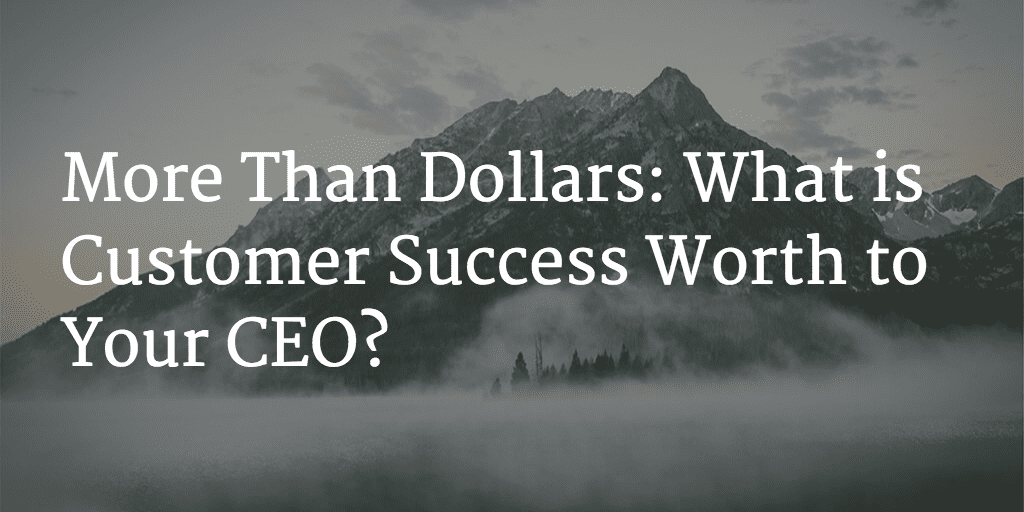Customer Success is More Than a Team of People:
- Stay with you longer (resulting in lower churn / higher lifetime value, or LTV)
- Want to buy more from you because they see value (resulting in higher LTV and Annual Contract Value / ACV); and
- Act as advocates and references for future customers (resulting in lower Customer Acquisition Cost, or CAC)
A plan for Customer Success investment, therefore, should consist of more than just hiring a team or adding people to a pre-existing team. The plan you deliver to your CEO should:
- quantify the results you’re trying to achieve;
- indicate how you’re planning on measuring those results; and
- articulate how processes, people and tools/technology are going to help you achieve them.
Likewise, what you ask of your CEO should be more than dollars to support additional headcount…
If You Really Want Results, and a Customer-Centric Culture, It Will Take a Village:
True Customer Success is going to take a cross-functional commitment from the entire management team, not just incremental headcount to interact with customers. When a proactively engaged CSM team discovers an opportunity (or a need) to really fix something in order to improve the customer experience, then the department in your company who owns that problem is going to need to engage and do what’s reasonably required to first resolve the current issue and then fix the root cause.
Be sure that as you justify the need for Customer Success to your CEO you also justify the need to the rest of the executive team. You’re not just selling Customer Success to your CEO, you’re selling it to your peers. You’re also not just asking for funding from your CEO, you’re enlisting cross-functional support for an organization that is going to be the focal point for a customer-centric company. Be passionate, be motivating, and be positive. Your customers are the reason your company exists. As you justify investment in, and support for, the Customer Success organization, it is important that you remind everyone of the importance of your customers and that you rally the entire company around your customer base.
What Are You Trying to Achieve?
While the primary goal of a Customer Success organization is to deliver value to your customer base, the specific, short-term pain every organization faces will not be the same. The business case you make and the objectives you measure to justify that (additional) investment should be specific to the pain that your company is facing (churn, lack of visibility, low upsell numbers, low customer engagement, etc).
Every company will have different Customer Success needs based upon their history, growth stage, philosophy, and prior investments in Customer Success. To make a solid business case that will get visibility and priority, you’ll need to take a good look at the current state of your specific Customer Success organization and realistically identify the measurable objectives of your next phase of investment. For example:
- Are you at the early stages of implementing Customer Success and do you need to get better data and visibility into your customer base? Are your customers catching you by surprise with cancellations? If so, look at creating short term goals and objectives around building a customer engagement model, then understanding, segmenting, and creating a health status for each of your customers. Once you have this data, you can then create additional business cases around specific improvements in your current customer base.
- Are you targeting specific improvements in one of the key metrics of Churn, Upsell, or Reference Customers? If so, then identify resources or technology needed to make those improvements and make some assumptions on the impact your investment will have. Look at your results on a regular basis and see how well your assumptions are doing. One very effective tool I’ve used in the past is a waterfall chart.
- Are you trying to take what you’ve learned engaging with a high-touch segment of your customer base and scale it so that you can apply it to more customers? If so, then look at investments in additional technology to help you segment your customer base and look at how you can apply a marketing automation solution to help your customers be more effective at using your technology.
- Do you have a mature, effective CSM organization already and are you now trying to get better at projecting and forecasting your renewals and upsells? In larger, more established companies, especially public companies, renewals represent a higher percentage of overall revenue than new business. In those companies, growth from upsells and cross-sells to existing customers can be equal to or greater than growth from new customers, so projecting and forecasting that revenue accurately is at least as important as projecting and forecasting new sales opportunities.
One Parting Thought:
I always like to look at “common sense” justification as well as quantifiable justification for any significant initiatives. As I thought about Customer Success, the following two “truths” came to mind to solidify the “common sense” justification:
- Companies need to deliver value to their customers;
- If the only time you talk to your customers is when: a) They reach out to your support organization because something is broken; or b) Your sales team calls them to sell them something… well, then, you’re going to have a hard time doing b).
There are many ways to justify a Customer Success function. Based on the specifics of your company, some of them will be more valuable, more obvious, or even more necessary than others. Understand that one size of Customer Success doesn’t fit all, go in with specific objectives, implement a plan of process, people, and technology, and measure your progress and results. Both your company and your customers will see tangible benefits.
